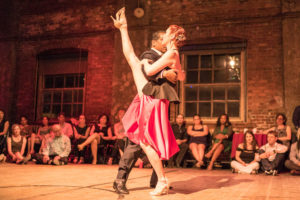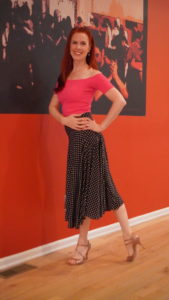
Jews started leaving Argentina around the same time tango dancing did.
From the 1930s to the ’50s, tango, a style of dance and music that originated from the working class in Buenos Aires, Argentina, was in its golden age. Bands of a dozen members would play the syncopated beats and dramatic strings for dancers across classes. The social dance was popular beyond South America in European metropolitans such as Paris, Berlin, Rome and Vienna.
By the early 1970s, however, a military junta and national political disarray saw tango nearly disappear in Argentina. The military dictatorship was also the reason many Argentine Jews — including descendants of Sephardic Jews who fled Spain after the Inquisition — left the country for safety to Israel or the United States.
Meredith Klein, the Jewish founder of the Philadelphia Argentine Tango School, is among the growing effort to rebuild the tango community, both in Argentina and Philadelphia, and she found Jewish camaraderie along the way.
Founded in 2008 and originally located on South Street, PATS has been the center of tango in Philadelphia, offering private and group classes, workshops and social gatherings for tango experts and neophytes alike.
Now in Fishtown, the school hosted the 10th Philadelphia Tango Festival last month. Klein performed with dance partner Andres Amarilla on July 2 at the Philadelphia Welcome America Festival, the first time the festival has included Latin dance.
Klein, 47, has danced tango for decades, partnering with Amarilla, who is also Jewish, for 17 years. After growing up in Narberth, Klein attended Amherst College and studied music theory.
A friend of hers was composing music and had just forayed into composing tango, and he invited her to a workshop in the area. Klein immediately fell in love with the dance.
“We were both blown away,” she said. “Blown away especially by the communication that’s part of dancing tango, because tango is a totally improvised dance. With every single step, one person is proposing, and the other is receiving the information, and it could be anything at any moment.”
Though Klein had a love of music at a young age, studying piano and voice, the discipline did not come easy to her. Her first time dancing tango, her instructor led her through a complicated step, but the ebb and flow of the improvised dance was intuitive to Klein.
“Because of the way you have to listen to the music in order to improvise with another person, you kind of have an illusion that you’re making the music,” Klein said.
After dancing tango in the Boston area for several years after school, Klein moved to Buenos Aires in 2005, where she lived and danced professionally for three years. It was there where she met Amarilla and connected with a group of other tango dancers, many of whom happened to be Jewish and had relatives who fled Europe to settle in South America.
“We’re from the same culture, the Jewish culture,” Klein said. “The culture of being Jewish and valuing education and thinking a lot about morality.”

Klein and Amarilla’s shared Judaism helped forge an “instantaneous” connection that transcended their time together in Buenos Aires.
After leaving Argentina, Klein and Amarilla toured and danced in more than 40 cities in short bursts of time. It was expensive to have long, drawn-out tours and stay in one place for too long. But after 15 years away from her Philadelphia-area home, Klein wanted to plant roots.
She returned to Philadelphia with Amarilla and opened PATS at a friend’s sculpture studio on South Street.
Even without experiencing the political turmoil that precipitated the waning of tango in Argentina, Klein experienced the faltering and rebuilding of tango culture in Philadelphia.
The studio rent increased rapidly, forcing PATS to relocate. Around the same time, the New Kensington Community Development Corp. was trying to build an arts quarter on Frankford Avenue in Fishtown. Klein took the leap and bought the building at the current location of 2030 Frankford Ave.
“They were enormously successful,” Klein said of the project. “They got all sorts of art space businesses to move in, and the art space businesses attracted lots of investment and people moving into the area.”
But COVID, which limited the in-person intimacy and community upon which tango was built, threatened PATS’ survival, though it tried its best to pivot to online events.
“The pandemic felt like a hatchet,” Klein said.
As PATS works to rebuild its audience to pre-COVID levels, Klein sees a silver lining after more than two years of struggling: Supporters within the tango community have responded with generosity, paying beyond what is asked to keep the school and its programming alive.
“It could make you cry,” Klein said. “It’s so beautiful.”



